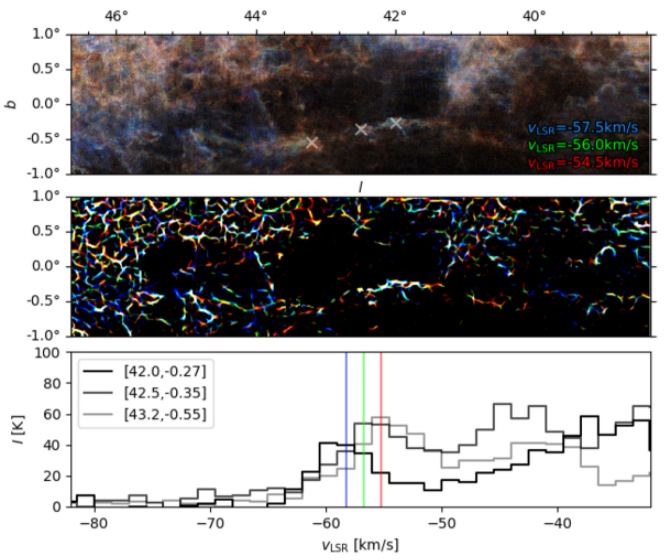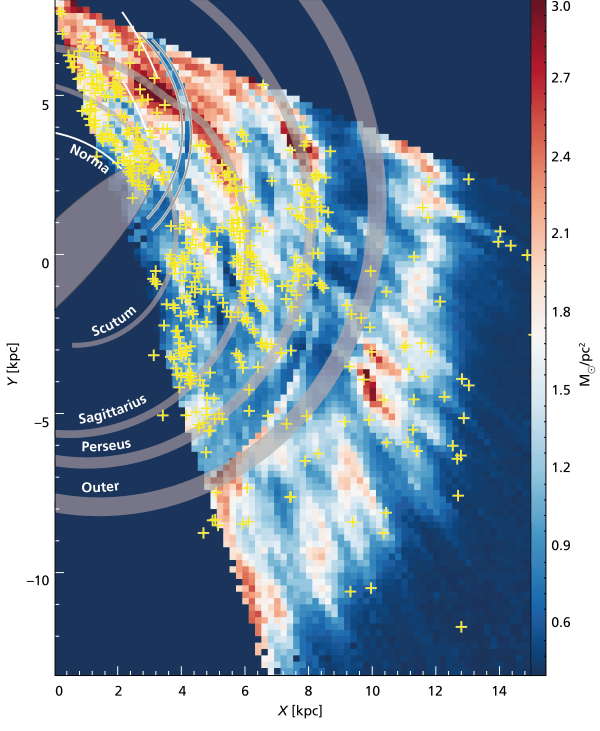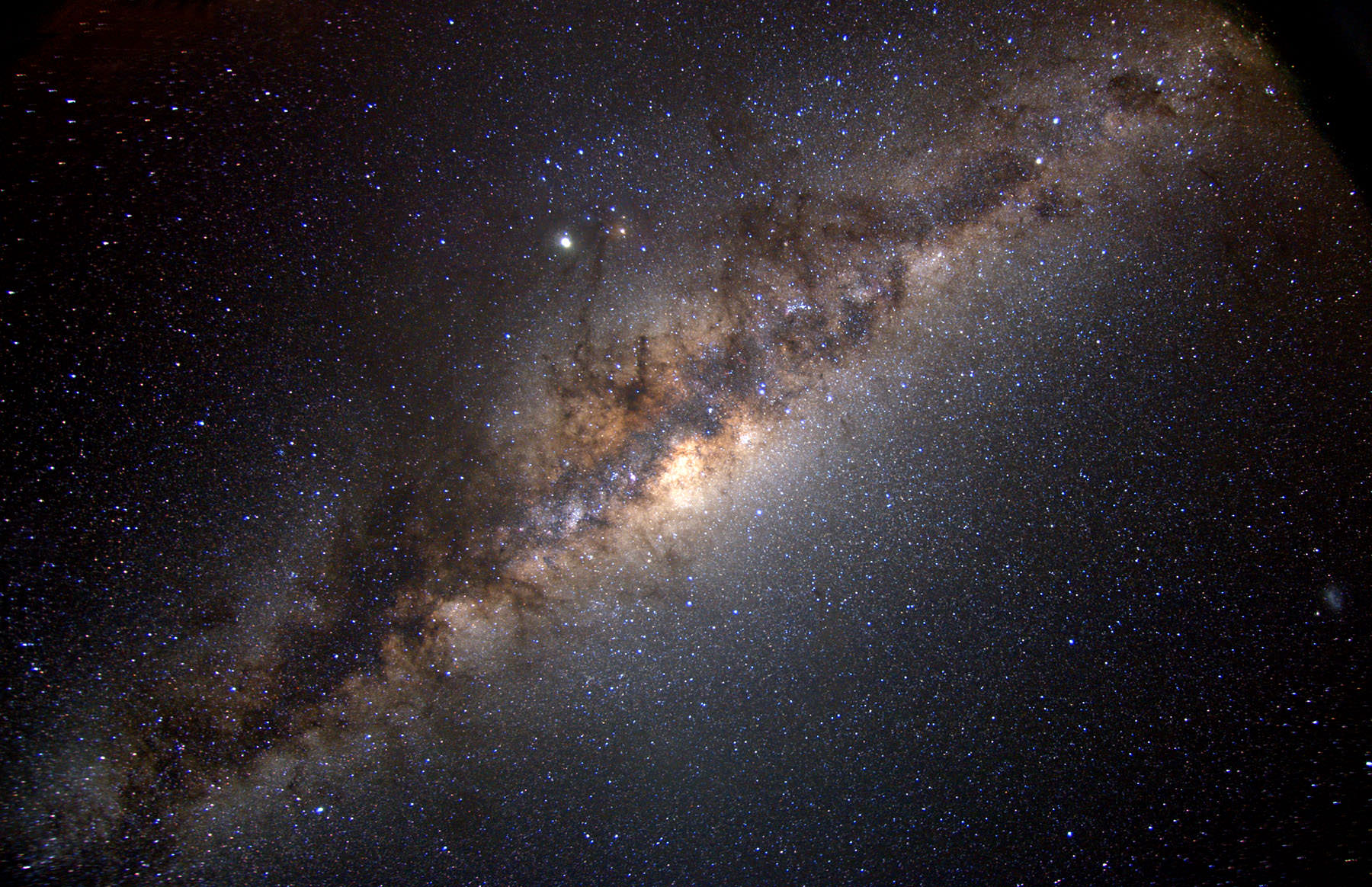A team of researchers has discovered a complex network of filamentary structures in the Milky Way. The structures are made of atomic hydrogen gas. And we all know that stars are made mostly of hydrogen gas.
Not only is all that hydrogen potential future star-stuff, the team found that its filamentary structure is also a historical imprint of some of the goings-on in the Milky Way.
The paper announcing this finding is titled “The history of dynamics and stellar feedback revealed by the HI filamentary structure in the disk of the Milky Way.” The lead researcher is Juan Diego Soler from the Max Planck Institute of Astronomy (MPIA). The paper is published in the journal Astronomy and Astrophysics.
The authors introduce their paper by saying “The diffuse neutral atomic hydrogen (HI) is the matrix within which star-forming clouds reside and the medium that takes in the energy injected by stellar winds, ionizing radiation, and supernovae. The observation of its distribution and dynamics provides a crucial piece of evidence to understand the cycle of energy and matter in the interstellar medium (ISM).
The study is based on an MPIA project called THOR (The HI/OH/Recombination line). THOR is a survey based on the famous H1 line or hydrogen line. The H1 line is an often used part of astronomical observations. It’s based on the spectral line produced by neutral hydrogen atoms when their energy state changes. The H1 line is at a 21 cm wavelength, which is easily observed by radio telescopes and can penetrate interstellar dust that blocks visible light.
“We are reconstructing the Milky Way history using the clouds of atomic hydrogen gas.”
Juan Diego Soler, Lead Researcher, MPIA
Because of the properties of the H1 line, and the Very Large Array (VLA) radio interferometer that gathered the data for THOR, the survey provides maps of gas distribution in the inner Milky Way “that have the highest spatial resolution to date,” according to a press release.
“The latest addition to the THOR data set is our data release 2 that includes a census of the neutral atomic hydrogen at an angular resolution of 40 arcseconds, Henrik Beuther explains, who leads the THOR project at MPIA, explained in the release.
Co-author Yuan Wang was partly responsible for processing the THOR data for this study. “We used the famous spectral line of hydrogen located at a wavelength of 21 cm,” Yuan Wang explains. “These data also provide the gas velocity in the direction of observation. Combined with a model of how the gas in the Milky Way disk rotates around its center, we even can infer distances,” Wang added. Thanks to the high resolution in the THOR observations, completely new studies were possible.
Lead author Soler was also responsible for processing the THOR data. He applied an algorithm to the data to get a better look at hydrogen distribution. The algorithm was the same one used in satellite image analysis and character recognition. That algorithm revealed the detailed filamentary nature of hydrogen.
Most of the hydrogen filaments are parallel to the Milky Way’s disk. One of the hydrogen lanes, which Soler named Magdalena after the longest river in his home country of Colombia, is 3,000 light-years long. At that length, it might be one of the largest structures in the entire galaxy.
“Maggie [Magdalena] could be the largest known coherent object in the Milky Way. In recent years, astronomers have studied many molecular filaments, but Maggie seems to be purely atomic. Because of its fortunate position in the Milky Way, we are lucky to have been able to spot it,” said Jonas Syed, a Ph.D. student at MPIA, who is also part of the THOR team.

But Maggie didn’t garner the most attention. Instead, the researchers were interested in a group of vertical hydrogen filaments.
The thing about the Milky Way is that it’s rotating. And that rotation should stretch out the hydrogen filaments parallel to and on the same plane as the Milky Way. So why is one group of filaments vertical?
“Like in the spinning pizza dough, we expected that most of the filaments would be parallel to the plane and stretched by the rotation. But when we found many vertical filaments around regions known for their high star formation activity, we knew we were onto something. Some process must have been blowing material off the Galactic plane,” Soler explained.
That process was likely massive stars that explode as supernovae at the end of their lives.
Those massive stars have powerful stellar winds with the power to shape their surroundings, including hydrogen, which is easily pushed around. The stars’ ionizing radiation helps the process along. This brings it around to the H1 line again.

The H1 line has been used for all sorts of observations, including searching for and identifying the gas shells around stars that have gone supernova. The powerful shock waves from supernova slam into hydrogen gas, causing it to build up into clumps, and sometimes triggering new star formation. But that isn’t quite what happened with the vertical filaments that THOR found.
Most of the vertical filaments of atomic hydrogen are in regions that have a known, long history of star formation. Several generations of stars and supernovae have shaped the region, and the team of researchers linked the vertical filaments to events that came long before the shells carved out by supernovae.
“Most likely, we are looking at the remnant of many older shells that popped when they reached the edge of the Galactic disk, accumulated over millions of years, and remain coherent thanks to the magnetic fields,” Soler explains.

This study gives us a new look at some of the dynamic processes going on in galaxies. It links observations with the physical processes that cause gas to accumulate, and then to form new stars. “Our results indicate that a systematic characterization of the emission morphology toward the Galactic plane provides an unexplored link between the observations and the dynamical behavior of the interstellar medium, from the effect of large-scale Galactic dynamics to the Galactic fountains driven by SNe,” the authors write in their paper.
“Galaxies are complex dynamical systems, and new clues are hard to obtain. Archaeologists reconstitute civilizations from the ruins of cities. Palaeontologists piece together ancient ecosystems from dinosaur bones. We are reconstructing the Milky Way history using the clouds of atomic hydrogen gas,” Soler concludes.
The team thinks that their methodology can be applied to other regions of the galaxy to reveal the nature of neutral atomic hydrogen structures. Will there be more Magdalenas?
“The statistical nature of our study unveils general trends in the structure of the atomic gas in the Galaxy and motivates additional high-resolution observations of the HI emission in other regions of the Galaxy,” the authors write in their conclusion. “Our results demonstrate that measuring the orientation of filamentary structures in the Galactic plane is a promising tool to reveal the imprint of the Galactic dynamics, stellar feedback, and magnetic fields in the observed structure of the Milky Way and other galaxies.”
More:
- Press Release: The archaeological record of the Milky Way written by atomic hydrogen
- New Research: The history of dynamics and stellar feedback revealed by the H?I filamentary structure in the disk of the Milky Way
- Universe Today: 7% of the Stars in the Milky Way’s Center Came From a Single Globular Cluster That Got Too Close and Was Broken Up

